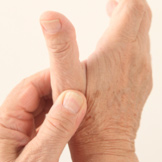
Any condition that irritates or destroys a joint is referred to as arthritis. Basilar thumb arthritis is the most common form of osteoarthritis affecting the hand. More prevalent in women than men, it typically occurs after the age of 40.
A prior history of fracture or any injury to the joint may increase the likelihood of developing arthritis. Repetitive heavy gripping and grasping activities can also contribute to symptom progression.
Basal Thumb Arthritis Symptoms
That pickle jar that you can’t open? It may be among the first signs of arthritis. Pain may also happen with “pinching” activities:
- turning doorknobs
- opening car doors
- turning keys
- wringing out rags
Prolonged heavy use and weather changes may also produce aching.
As symptoms progress, aching and weakness of pinch and grip also worsen. Eventually, any thumb motions, even those without stress, become painful.
With time, the basilar thumb joint will become enlarged and motion will be impaired. It becomes difficult to pull the thumb away from the hand to grasp an object. In severe cases, the thumb collapses into the hand, and other joints may assume an abnormal position to permit grasping.
To determine if you have arthritis, a hand specialist will conduct a physical exam, including observation of the enlarged joint, and conduct a “grind test” to provoke symptoms. X-rays will show the joint deterioration.
Basal Thumb Arthritis Treatments
Initial treatments include nonsurgical pain control and function improvements. Anti-inflammatory medications such as Ibuprofen, activity modification, and wearing a protective splint may be recommended. Splinting helps decrease motion and stresses at the joint. Cortisone injections may also be used.
When these measures no longer provide relief, surgery may be needed. Two types of outpatient surgeries are available and take about 60 to 90 minutes:
- Arthritic Joint Fusion prevents movement throughout the joint and relieves pain. Appropriate candidates are those who don’t need a significant degree of motion restored and who regularly perform heavy activities that would eventually wear out a joint replacement. Patients will still have some motion through wrist joints near the fusion site.
- Joint Replacement is ideal for decreasing pain and preserving joint motion. In fact, it is the more common approach of the two interventions. Artificial basilar thumb joints have not been very effective but an alternative does exist.
The most common procedure uses no artificial components to reconstruct the joint. The destroyed joint is removed and a substitute is created. All or part of the arthritic bone is removed, and a tendon from the wrist creates a sling suspension. This surgery has proven to be very successful in relieving pain and returning function.
After surgery, a splint is worn for about six weeks and then physical therapy helps the patient gradually regain motion and strength. A return to full activity usually occurs in 10 to 12 weeks.